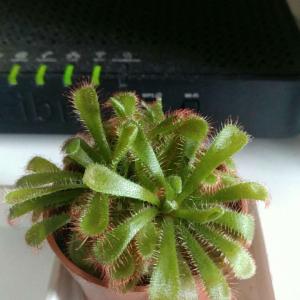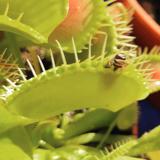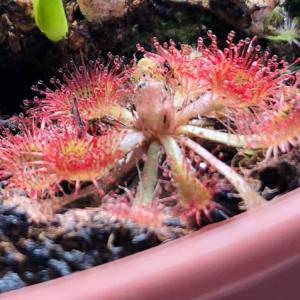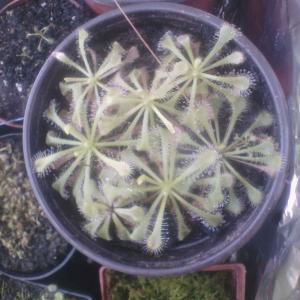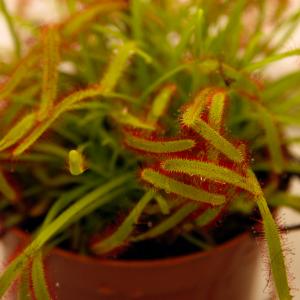文章
玲儿
2017年09月21日

モウセンゴケ(ドロセラ)の仲間の基本情報
学名:Drosera
和名:モウセンゴケ その他の名前:ドロセラ
科名 / 属名:モウセンゴケ科 / モウセンゴケ属(ドロセラ属)
特徴
モウセンゴケの仲間は、葉の表面に生える繊毛から消化酵素を含む粘液を出し、その粘着力で獲物を捕らえる食虫植物です。獲物を捕らえると養分を消化・吸収するまで落とさないように、葉が巻き込むように曲がります。
モウセンゴケの仲間は全世界に分布し、生態も多種多様です。球根性の種類、ピグミードロセラと呼ばれるごく小型の種類、多年草から一年草の種類まで、さまざまです。
生育型で大きく分けると、冬芽をつくって冬を越す「寒地性」と「温帯性」のものと、冬芽をつくらない「熱帯性」の3つに分けることができます。国内で一般的に流通するのは温帯性のものと熱帯性のものが多く、寒地性のものは暑さに弱いためあまり出回りません。
日本に自生している種類としては、モウセンゴケ、コモウセンゴケ、トウカイコモウセンゴケ、ナガバノモウセンゴケ、ナガバノイシモチソウ、イシモチソウの6種とその交雑種が知られています。
種類(原種、園芸品種)
アフリカナガバノモウセンゴケ
Drosera capensis
南アフリカ原産の、最も丈夫な種類。赤花種と白花種がある。本来熱帯性だが、軽い霜くらいであれば耐え、宿根する。

イトバモウセンゴケ
Drosera filiformis
北アメリカ原産の温帯種。40cmほどの葉をまっすぐ上に伸ばして捕虫する。花はピンク色。耐寒性もあり丈夫で、冬芽をつくって冬を越す。
サスマタモウセンゴケ
Drosera binata
オーストラリア原産。通常種は葉先が二叉に分かれるが、四叉、八叉、それ以上に分かれる品種もある。熱帯性だが夏の暑さに弱い系統もある。

モウセンゴケ
Drosera rotundifolia
北半球の寒地や高山に広く分布し、いわゆる属の名前の由来になった種類。夏の暑さに弱く、栽培には少し気を使う。

アデレーモウセンゴケ
Drosera adelae
剣状の葉が特徴的な種類で、オーストラリア原産。モウセンゴケの仲間としては珍しく、日当たりの悪い場所でも栽培できる。
クルマバモウセンゴケ
Drosera burmannii
オーストラリアから南アジア原産。モウセンゴケの仲間としては珍しい一年草で、捕虫時の葉の繊毛の動きはゆっくりではあるが目で見てわかる速さで動く。
学名:Drosera
和名:モウセンゴケ その他の名前:ドロセラ
科名 / 属名:モウセンゴケ科 / モウセンゴケ属(ドロセラ属)
特徴
モウセンゴケの仲間は、葉の表面に生える繊毛から消化酵素を含む粘液を出し、その粘着力で獲物を捕らえる食虫植物です。獲物を捕らえると養分を消化・吸収するまで落とさないように、葉が巻き込むように曲がります。
モウセンゴケの仲間は全世界に分布し、生態も多種多様です。球根性の種類、ピグミードロセラと呼ばれるごく小型の種類、多年草から一年草の種類まで、さまざまです。
生育型で大きく分けると、冬芽をつくって冬を越す「寒地性」と「温帯性」のものと、冬芽をつくらない「熱帯性」の3つに分けることができます。国内で一般的に流通するのは温帯性のものと熱帯性のものが多く、寒地性のものは暑さに弱いためあまり出回りません。
日本に自生している種類としては、モウセンゴケ、コモウセンゴケ、トウカイコモウセンゴケ、ナガバノモウセンゴケ、ナガバノイシモチソウ、イシモチソウの6種とその交雑種が知られています。
種類(原種、園芸品種)
アフリカナガバノモウセンゴケ
Drosera capensis
南アフリカ原産の、最も丈夫な種類。赤花種と白花種がある。本来熱帯性だが、軽い霜くらいであれば耐え、宿根する。

イトバモウセンゴケ
Drosera filiformis
北アメリカ原産の温帯種。40cmほどの葉をまっすぐ上に伸ばして捕虫する。花はピンク色。耐寒性もあり丈夫で、冬芽をつくって冬を越す。
サスマタモウセンゴケ
Drosera binata
オーストラリア原産。通常種は葉先が二叉に分かれるが、四叉、八叉、それ以上に分かれる品種もある。熱帯性だが夏の暑さに弱い系統もある。

モウセンゴケ
Drosera rotundifolia
北半球の寒地や高山に広く分布し、いわゆる属の名前の由来になった種類。夏の暑さに弱く、栽培には少し気を使う。

アデレーモウセンゴケ
Drosera adelae
剣状の葉が特徴的な種類で、オーストラリア原産。モウセンゴケの仲間としては珍しく、日当たりの悪い場所でも栽培できる。
クルマバモウセンゴケ
Drosera burmannii
オーストラリアから南アジア原産。モウセンゴケの仲間としては珍しい一年草で、捕虫時の葉の繊毛の動きはゆっくりではあるが目で見てわかる速さで動く。
0
0
文章
Dummer. ゛☀
2017年08月21日

Sundews (Drosera spp.) are carnivorous plants with an ingenious way to catch their prey. Carnivorous sundew plants have sticky pads that trap insects. The plants are also attractive, often brightly colored rosettes. Growing sundews is common in terrariums or other warm, moist areas that mimic their natural bog habitat. A few tips on how to care for a sundew will have you on your way to enjoying this fascinating plant.
Sundew Plant Information
There are over 90 species of sundew. The majority are found in Australia and South Africa, but they also grow in hot, humid areas of Georgia, Florida and other similar climates. The plants prefer acidic soils and are usually where there is a bog or marsh and often grow on top of sphagnum moss. Sundews are in the genera Drosera and common varieties are often seen in houseplant stores. Sundew plant information wouldn’t be complete without explaining the trap mechanism. The plant has tiny arms or stems covered at the tips with sticky filaments. These filaments secrete a substance that will not only catch small prey but will also digest them. The arms fold in to hold the insect for four to six days until it is completely digested.
Growing Sundews
Whether you grow them indoors or out, carnivorous sundew plants are excellent for controlling gnats and other tiny insects. Sundew plants thrive as potted plants in a mixture of sphagnum moss and vermiculite or perlite. The pot must be kept constantly moist and an atmosphere of humidity is best for maximum growth. Carnivorous sundew plants need warm temperatures and moist conditions. Outdoor plants do well when planted near a water feature or even in soggy soil. When growing sundews outdoors, till soil completely and mix in sphagnum moss to increase the acidity. Full sun situations suit the plant best, but you can also grow them in dappled light.
How to Care for a Sundew
Potted plants do not need fertilizer but do require either distilled or rainwater, as they are not tolerant of high levels of minerals. Provide a humidity level of 40 to 60 percent. This is easy to do by setting a saucer filled with small pebbles under the plant and filling it with water. The evaporation will help moisten the ambient air. Cut off spent stems and leaves as they occur. Transplant them when they outgrow their pots. There are some varieties of Drosera that are more hardy than others. Check with your extension office for plant recommendations for your area. Follow the instructions on how to care for a sundew and grow a fascinating and useful plant in the garden.

Sundew Plant Information
There are over 90 species of sundew. The majority are found in Australia and South Africa, but they also grow in hot, humid areas of Georgia, Florida and other similar climates. The plants prefer acidic soils and are usually where there is a bog or marsh and often grow on top of sphagnum moss. Sundews are in the genera Drosera and common varieties are often seen in houseplant stores. Sundew plant information wouldn’t be complete without explaining the trap mechanism. The plant has tiny arms or stems covered at the tips with sticky filaments. These filaments secrete a substance that will not only catch small prey but will also digest them. The arms fold in to hold the insect for four to six days until it is completely digested.

Growing Sundews
Whether you grow them indoors or out, carnivorous sundew plants are excellent for controlling gnats and other tiny insects. Sundew plants thrive as potted plants in a mixture of sphagnum moss and vermiculite or perlite. The pot must be kept constantly moist and an atmosphere of humidity is best for maximum growth. Carnivorous sundew plants need warm temperatures and moist conditions. Outdoor plants do well when planted near a water feature or even in soggy soil. When growing sundews outdoors, till soil completely and mix in sphagnum moss to increase the acidity. Full sun situations suit the plant best, but you can also grow them in dappled light.

How to Care for a Sundew
Potted plants do not need fertilizer but do require either distilled or rainwater, as they are not tolerant of high levels of minerals. Provide a humidity level of 40 to 60 percent. This is easy to do by setting a saucer filled with small pebbles under the plant and filling it with water. The evaporation will help moisten the ambient air. Cut off spent stems and leaves as they occur. Transplant them when they outgrow their pots. There are some varieties of Drosera that are more hardy than others. Check with your extension office for plant recommendations for your area. Follow the instructions on how to care for a sundew and grow a fascinating and useful plant in the garden.
0
0



